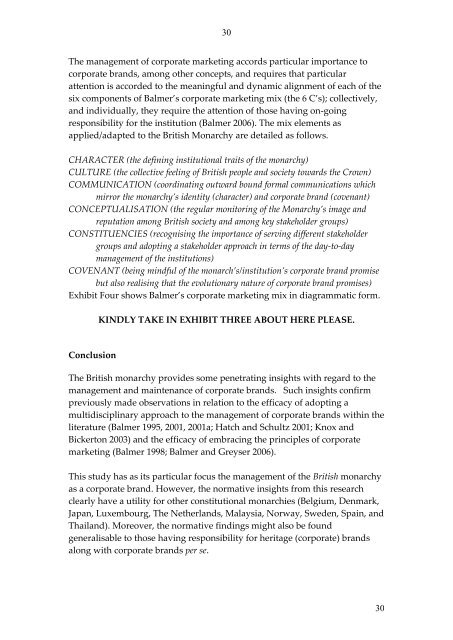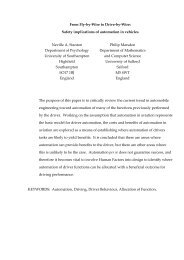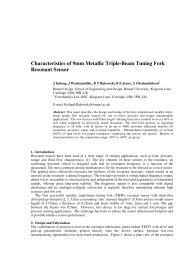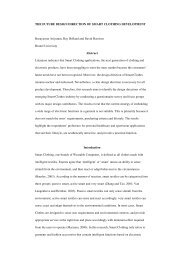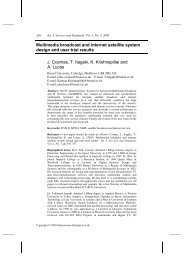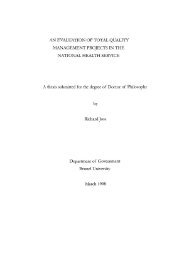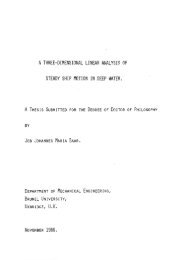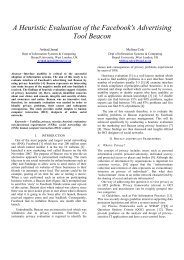insights from the british monarchy - BURA - Brunel University
insights from the british monarchy - BURA - Brunel University
insights from the british monarchy - BURA - Brunel University
Create successful ePaper yourself
Turn your PDF publications into a flip-book with our unique Google optimized e-Paper software.
30<br />
The management of corporate marketing accords particular importance to<br />
corporate brands, among o<strong>the</strong>r concepts, and requires that particular<br />
attention is accorded to <strong>the</strong> meaningful and dynamic alignment of each of <strong>the</strong><br />
six components of Balmer’s corporate marketing mix (<strong>the</strong> 6 C’s); collectively,<br />
and individually, <strong>the</strong>y require <strong>the</strong> attention of those having on-going<br />
responsibility for <strong>the</strong> institution (Balmer 2006). The mix elements as<br />
applied/adapted to <strong>the</strong> British Monarchy are detailed as follows.<br />
CHARACTER (<strong>the</strong> defining institutional traits of <strong>the</strong> <strong>monarchy</strong>)<br />
CULTURE (<strong>the</strong> collective feeling of British people and society towards <strong>the</strong> Crown)<br />
COMMUNICATION (coordinating outward bound formal communications which<br />
mirror <strong>the</strong> <strong>monarchy</strong>’s identity (character) and corporate brand (covenant)<br />
CONCEPTUALISATION (<strong>the</strong> regular monitoring of <strong>the</strong> Monarchy’s image and<br />
reputation among British society and among key stakeholder groups)<br />
CONSTITUENCIES (recognising <strong>the</strong> importance of serving different stakeholder<br />
groups and adopting a stakeholder approach in terms of <strong>the</strong> day-to-day<br />
management of <strong>the</strong> institutions)<br />
COVENANT (being mindful of <strong>the</strong> monarch’s/institution’s corporate brand promise<br />
but also realising that <strong>the</strong> evolutionary nature of corporate brand promises)<br />
Exhibit Four shows Balmer’s corporate marketing mix in diagrammatic form.<br />
Conclusion<br />
KINDLY TAKE IN EXHIBIT THREE ABOUT HERE PLEASE.<br />
The British <strong>monarchy</strong> provides some penetrating <strong>insights</strong> with regard to <strong>the</strong><br />
management and maintenance of corporate brands. Such <strong>insights</strong> confirm<br />
previously made observations in relation to <strong>the</strong> efficacy of adopting a<br />
multidisciplinary approach to <strong>the</strong> management of corporate brands within <strong>the</strong><br />
literature (Balmer 1995, 2001, 2001a; Hatch and Schultz 2001; Knox and<br />
Bickerton 2003) and <strong>the</strong> efficacy of embracing <strong>the</strong> principles of corporate<br />
marketing (Balmer 1998; Balmer and Greyser 2006).<br />
This study has as its particular focus <strong>the</strong> management of <strong>the</strong> British <strong>monarchy</strong><br />
as a corporate brand. However, <strong>the</strong> normative <strong>insights</strong> <strong>from</strong> this research<br />
clearly have a utility for o<strong>the</strong>r constitutional monarchies (Belgium, Denmark,<br />
Japan, Luxembourg, The Ne<strong>the</strong>rlands, Malaysia, Norway, Sweden, Spain, and<br />
Thailand). Moreover, <strong>the</strong> normative findings might also be found<br />
generalisable to those having responsibility for heritage (corporate) brands<br />
along with corporate brands per se.<br />
30


